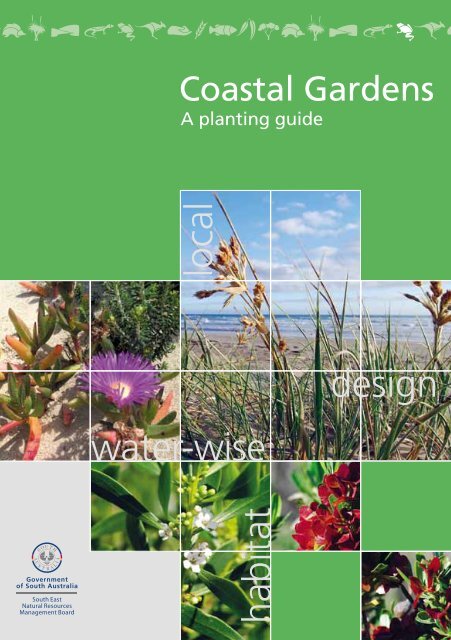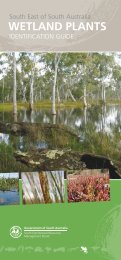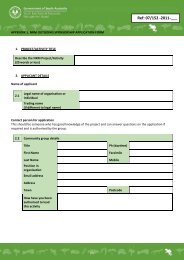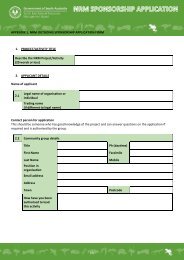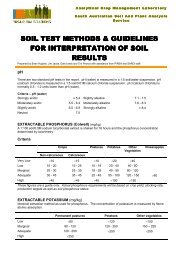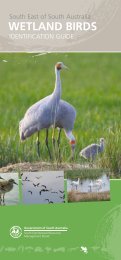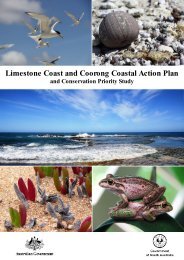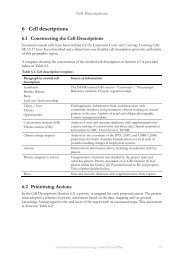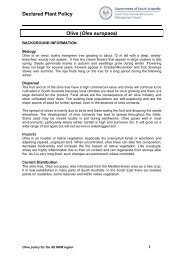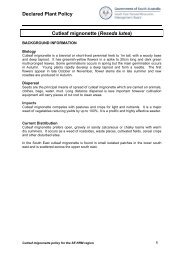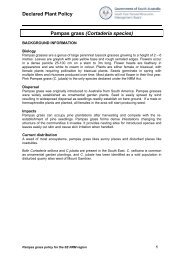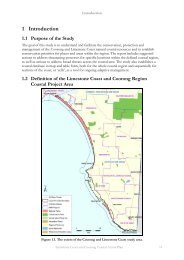Coastal Gardens - South East Natural Resources Management ...
Coastal Gardens - South East Natural Resources Management ...
Coastal Gardens - South East Natural Resources Management ...
You also want an ePaper? Increase the reach of your titles
YUMPU automatically turns print PDFs into web optimized ePapers that Google loves.
<strong>Coastal</strong> <strong>Gardens</strong><br />
A planting guide<br />
local<br />
water-wise<br />
habitat<br />
design
Healthy & attractive landscapes<br />
This guide provides simple yet inspiring garden advice for people living in the<br />
coastal regions of the <strong>South</strong> <strong>East</strong> of <strong>South</strong> Australia.<br />
1 Using this planting guide<br />
2 Benefits of local plants<br />
4 Garden escapes<br />
6 Trees & tall shrubs<br />
8 Medium shrubs<br />
10 Ground covers, herbs<br />
& small shrubs<br />
14 Grasses & sedges<br />
16 Climbers<br />
18 <strong>Natural</strong> cottage garden design<br />
20 Formal garden design<br />
22 Japanese style garden design<br />
24 Contemporary garden design<br />
26 Growing local coastal plants<br />
28 Sourcing local coastal plants<br />
29 Useful resources
Using this planting guide<br />
Getting started<br />
Our gardens are challenged with long-hot-dry summers, drought, water<br />
restrictions, and a changing climate. As a coastal resident you may also<br />
have to tackle salt spray, sand blasting, sandy or saline soils.<br />
However, there is good news! You can have a garden that copes with<br />
our tough climate without compromising on style, by using resilient, local<br />
native coastal plants.<br />
This guide shows you how to utilise the fantastic variety of native plants<br />
available to make a stunning garden. Taking you through step by step,<br />
you will learn what plant works best for a given area or need, how to<br />
incorporate them in different landscaping styles, how to maintain them,<br />
and where to buy.<br />
You will learn about plants to avoid which are known for becoming serious<br />
weeds in natural coastal environments. When buying future plants, you will<br />
be prepared to consider natives for the benefits they provide. You may also<br />
identify invasive plants growing in your garden and decide to replace them<br />
with recommended alternatives.<br />
Using local native plants in your coastal garden benefits your wallet. Its an<br />
easy, rewarding way to look after our environment. We hope you enjoy<br />
discovering local coastal plants. Happy gardening!<br />
1
Benefits of local plants<br />
What is a<br />
local plant?<br />
Why use<br />
local plants?<br />
Local plants are species that would naturally occur in your neighbourhood<br />
so they have evolved to suit local conditions. They are also called<br />
‘indigenous plants’.<br />
Local plants have a huge range of benefits.<br />
Low maintenance.<br />
Drought tolerant.<br />
Require minimal watering = conserves our water supplies.<br />
Don’t need fertilisers or pesticides.<br />
Provide habitat, food and shelter, attracting native fauna such as birds,<br />
butterflies and lizards.<br />
Saves you money and time. Using waterwise plants can save you up to<br />
50% of your garden water use each year.<br />
Adaptable for various landscaping styles, producing striking results.<br />
Native plants flower at different times of the year so you can have a<br />
flowering garden all year round.<br />
Local plants are a great option for residents of coastal areas and ideal for<br />
weekenders who are looking for “easy care” gardens . They have adapted<br />
to survive the harsh conditions of sand and salt blasting, prolonged sun<br />
exposure, nutrient-deprived soils, and limited water availability. They are the<br />
best plants for your neighbourhood and the environment.
How to use<br />
local plants<br />
Local plants can be incorporated into your garden the same way as exotic<br />
plants. They are suited to all landscaping styles, from formal to Japanese,<br />
contemporary to natural cottage, to courtyards and pots.<br />
As you will discover throughout this guide, there is a local coastal plant for<br />
most garden situations. Plants featured include striking ground-covers, low<br />
shrubs, structured sedges and grasses, flowering creepers and trailers, birdattracting<br />
shrubs and screening trees.<br />
This guide also shows you which local species to use for particular effects,<br />
and recommends environmentally friendly alternatives to potentially<br />
invasive coastal weeds.<br />
Information on caring for local plants is provided on pages 26–27.<br />
3
Garden escapes<br />
Are you<br />
harbouring<br />
known<br />
villains?<br />
How do<br />
garden plants<br />
become coastal<br />
invaders?<br />
Weeds are plants growing where they aren’t wanted, and they aren’t just<br />
sour sobs and thistles! Some plants escape from gardens and become<br />
serious environmental weeds which pose a major threat to the health and<br />
value of our natural environments.<br />
Environmental weeds are trouble!<br />
They compete with local native plants and environment.<br />
Can reduce habitat, shelter and food for native fauna.<br />
Can alter soil conditions.<br />
Clog up waterways and effect water quality entering the ocean.<br />
Can alter coastal dune shape.<br />
Garden escapes are very costly to control and take resources away from<br />
other important issues.<br />
Plants that cause problems often originate from regions with similar<br />
climates, such as the Mediterranean and <strong>South</strong> Africa. Thriving in similar<br />
conditions, they out-compete local natives as they don’t have the pests and<br />
diseases that controlled them in their original environment.<br />
You might not realise you’re harbouring garden escapes, or might not know<br />
they ‘jump the fence’ to become problems. Garden plants can escape into<br />
natural environments naturally, accidentally and deliberately:<br />
Seeds can be spread by birds and other animals, wind, water<br />
(including stormwater) or humans (on clothing, shoes etc).<br />
Dumped garden waste containing seeds or plant cuttings can grow<br />
even several months later.<br />
Sometimes people deliberately plant garden plants in our natural<br />
coastal environments.<br />
Garden plants can grow through fences directly on the coast.
You can<br />
help!<br />
Have a good look through this guide to check which common garden<br />
plants are nasties in the coastal environment. You might like to remove any<br />
you have and replace them with the indigenous plants suggested. Take this<br />
guide with you when you are making new plant purchases and don’t buy<br />
plants which are known to be a problem.<br />
Here are some other easy things you can do.<br />
Use local native species in your garden.<br />
Dispose of your garden waste responsibly.<br />
Check with your local council before you plant into natural coastal<br />
environments .<br />
Join a local environmental group to learn more about our coast and<br />
lend a hand! Call the SE NRM Board on 8724 6000 or go to<br />
www.senrm.sa.gov.au for information on how to get involved.<br />
Be aware that different weeds need to be controlled by different methods;<br />
there are physical, biological and chemical methods for controlling weeds.<br />
To learn more about identifying and controlling garden escapes, contact<br />
the <strong>South</strong> <strong>East</strong> <strong>Natural</strong> <strong>Resources</strong> <strong>Management</strong> Board on (08) 8724 6000.<br />
5
Trees & tall shrubs<br />
DON’T PLANT a garden escapee!<br />
photo by John Tann<br />
Coast Tea-tree<br />
Leptospermum laevigatum<br />
(<strong>East</strong> coast Australia & Tasmania)<br />
Flowers: August to November<br />
Reproduces: seed (woody capsule)<br />
Cotoneaster<br />
Cotoneaster sp.<br />
(China) Flowers: spring/summer<br />
Reproduces: clusters of small<br />
berries in autumn/winter<br />
Shiny Leaf Coprosma repens<br />
(New Zealand)<br />
Flowers: summer<br />
Reproduces: orange-red berries<br />
autumn to winter (seed)<br />
Italian Buckthorn Rhamnus alaternus<br />
(Mediterranean)<br />
Flowers: winter to early spring<br />
Reproduces: fleshy black fruits,<br />
will reshoot from base if damaged<br />
English Broom<br />
Cytisus scoparius<br />
(Europe) Flowers: late spring<br />
Reproduces: seed pods eject<br />
seeds in summer
GROW ME instead<br />
Drooping Sheoak Allocasuarina verticillata<br />
Tree growing between 5-8m. Long weeping branchlets, grey-green.<br />
Interesting cone-like fruit. Well suited to Japanese gardens. Use as feature tree<br />
or for screening. Birds such as parrots and cockatoos are attracted to fruit.<br />
Does not tolerate direct coastal exposure.<br />
Common Boobialla Myoporum insulare<br />
Large shrub to small tree, grows 2–5m. Thick light green<br />
fleshy leaves, white flowers winter to spring, purple<br />
berry fruit. Good screening qualities. Attracts birds and<br />
butterflies. Full-sun.<br />
<strong>South</strong> Australian Blue Gum Eucalyptus leucoxylon ssp megalocarpa<br />
A spreading tree, 4 to 10m high. Dark, glossy green leaves, white, pink or red<br />
flowers from March to December. Suitable for coastal exposure, and drought<br />
resistant. Moderately fast grower and responds well to pruning.<br />
Sticky Hop-bush Dodonaea viscosa<br />
Erect shrub to 3m, bright green sticky leaves. Green<br />
flowers in winter turn to striking red seed pods in spring.<br />
Great for hedging or screening. Responds to pruning.<br />
Attracts butterflies in summer. Does not tolerate direct<br />
coastal exposure.<br />
Dryland tea-tree Melaleuca lanceolata<br />
Medium sized small tree to 7m high, green narrow leaves.<br />
White to cream flowers in a bottle brush shape during summer.<br />
Fruit a spherical shape 4-5mm long.<br />
Silver Banksia Banksia marginata<br />
Feature tree grows 3–5m. Leaves green on top, silver<br />
under. Large yellow flowers spring to autumn. Interesting<br />
foliage and seed pods. Attracts birds and butterflies.<br />
Full-sun. Does not tolerate direct coastal exposure.<br />
7
Medium Shrubs<br />
DON’T PLANT a garden escapee!<br />
Teneriffe Daisy<br />
Argyranthemum Frutescens Ssp. foeniculaceum<br />
(Canary Islands)<br />
Flowers: spring<br />
Reproduces: seed<br />
Myrtle-leaf Milkwort<br />
Polygala myrtifolia<br />
(<strong>South</strong> Africa)<br />
Flowers: late winter to spring.<br />
Reproduces: seed<br />
Tufted Honey-flower<br />
Melianthus comosus<br />
(<strong>South</strong> Africa)<br />
Flowers: late spring to mid summer<br />
Reproduces: seed<br />
Boneseed<br />
Chrysanthemoides Monilifera Ssp. monilifera<br />
(<strong>South</strong> Africa)<br />
Flowers: late autumn to winter<br />
Reproduces: fleshy fruit (seed)<br />
New Zealand Karo Pittosporum crassifolium<br />
(New Zealand)<br />
Flowers: spring<br />
Reproduces: flowers develop into seed pods which release<br />
sticky seeds in autumn.
GROW ME instead<br />
Coast Daisy Bush Olearia axillaris<br />
Shrub to 3m. Leaves dark blue-green above, white below. White,<br />
daisy-like flowers occur along stems in summer and autumn.<br />
Benefits from pruning. Screening plant, foliage contrast.<br />
Full-sun to semi-shade.<br />
Sea Box<br />
Alyxia buxifolia<br />
Shrub to 2m high, thick green leaves and white flowers<br />
between spring and autumn. Tolerates coastal exposure.<br />
Holly Grevillea<br />
Grevillea aquifolium<br />
Variable in size occuring as scrambling plant or shrub reaching about 1<br />
to 2m high. Foliage has sharp points and red, greenish/yellow flowers<br />
“toothbrush” shaped. Honey eating birds are attracted to the flowers.<br />
Coast Beard-heath Leucopogan parviflorus<br />
Densely foliated shrub to 2m high with dark green<br />
oblong leaves and white flowers from July to September.<br />
Fruit round, white and edible during spring and summer.<br />
Tolerates coastal conditions.<br />
Round Leaf Wattle Acacia acinacea<br />
Shrub to 2m. Small rounded green leaves (phyllodes). Bright yellow wattle<br />
flowers from May to September. Provides burst of colour over winter. Weeping<br />
habit, well-suited to Japanese style garden. Lives 8–10 years. Does not tolerate<br />
direct coastal exposure.<br />
9
Ground covers, herbs & small shrubs<br />
DON’T PLANT a garden escapee!<br />
Gazania Gazania Sp.<br />
(<strong>South</strong> Africa)<br />
Flowers: most of year, mainly spring to autumn<br />
Reproduces: seed, vegetatively<br />
Hottentot Fig Carpobrotus edulis<br />
(<strong>South</strong> Africa)<br />
Flowers: late summer to winter<br />
Reproduces: fleshy fruit in summer,<br />
also spreads by vegetative production<br />
White Arctotis Arctotis stoechadifolia<br />
(<strong>South</strong> Africa)<br />
Flowers: spring to summer<br />
Reproduces: seed<br />
Beach Daisy Arctotheca populifolia<br />
(<strong>South</strong> Africa)<br />
Flowers: winter to summer<br />
Reproduces: seed<br />
Succulents<br />
(tropical & sub-tropical dry regions)<br />
Flowers: various<br />
Reproduces: most species will also spread<br />
by vegetative growth, some set seed
GROW ME instead<br />
Austral Trefoil Lotus australis<br />
Spreading herb to 30cm. Pale green leaves, white to pink pea flowers<br />
occur in clusters, spring to summer. Pretty plant, suits cottage or<br />
bushland garden. Can plant in pots. Prune after flowering.<br />
Full-sun to semi-shade.<br />
Coast Bonefruit Threlkeldia diffusa<br />
Small shrub or groundcover to 20cm high, 1m wide.<br />
Small fleshy leaves, green with purple tinge. Soil<br />
stabiliser. Tolerates saline conditions, clay. Full-sun.<br />
Creeping Boobialla Myoporum parvifolium<br />
Ground runner growing shin high to 5m wide. Small green leaves, dainty white<br />
or pale purple flowers in spring or summer. Good soil stabiliser. Space filler. Trail<br />
down rock walls. Lawn replacement (where no foot traffic). Attracts butterflies,<br />
provides shelter for small lizards. Does not tolerate direct coastal exposure.<br />
Seaberry Saltbush Rhagodia candolleana<br />
Spreading shrub to several metres wide with fleshy<br />
green leaves and small clusters of white flowers.<br />
Fruit ripens to a deep red from summer to autumn and<br />
are globular.<br />
Thyme Rice Flower<br />
Pimelea serpyllifolia<br />
Small, compact shrub to about 50cm high, small and crowded foliage. Flowers<br />
are greenish yellow hidden amongst leaves.<br />
11
Ground covers, herbs & small shrubs<br />
GROW ME instead<br />
Muntries Kunzea pomifera<br />
Ground-hugging shrub with branches extending over several metres. Thick<br />
bright green leaves, showy white fluffy flowers in spring and early summer.<br />
Purple berries. Space filler. Suitable for pots and hanging baskets. Full-sun to<br />
semi-shade. Ripe fruits are edible.<br />
Cushion Bush Leucopyhta brownii<br />
Compact, rounded shrub to 1m. Silver-grey foliage, pale<br />
yellow ball-shaped flowers in summer. Great structural<br />
form, colour contrast. Responds well to regular pruning.<br />
Contrast plant. Full-sun.<br />
Native Pelargonium Pelargonium australe<br />
Herb to knee high. Large green velvety leaves, pale pink flowers with purple<br />
stripe occur spring to summer. Pretty plant, great in cottage or bushland<br />
garden. Can plant in pots. Prune after flowering. Full-sun to semi-shade.<br />
Native Fuchsia Correa reflexa<br />
Small shrub with dark green leaves, pink bell flowers in<br />
winter and spring. Attractive flowers, great in formal,<br />
cottage or bush-land garden settings. Attracts birds.<br />
Full-sun to shade. Does not tolerate direct coastal<br />
exposure.<br />
Native Pigface Carpobrotus rossii<br />
Thick, fleshy ground cover. Green leaves triangular in cross-section,<br />
large bright pink flowers occur in spring. Attractive ground-cover, soil<br />
stabiliser. Suitable as trailing plant for pots or down walls.<br />
Ripe fruits are edible.
GROW ME instead<br />
Sand Ixodia<br />
Ixodia achillaeoides Ssp. (Arenicola)<br />
Low, reclining shrub 35 to 55cm high. Flat, dark green leaves and white, papery<br />
flowers during summer. Is rated as vulnerable under Commonwealth legislation.<br />
Paper Flower<br />
Thomasia petalocalyx<br />
Small shrub to 25cm, soft, furry appearance with lilac<br />
cup-shaped flowers from October to January. Requires<br />
little attention once plant is established.<br />
Dune Fan-flower<br />
Scaevola calendulacea<br />
Sprawling leafy creeper with thick and hairy foliage.<br />
Fan shaped flowers with 5 petals, pale blue colour most of the year and a<br />
purple coloured berry.<br />
Running Postman Kennedia prostrata<br />
Prostrate runner to 2m. Leaves pale green, bright red peaflowers<br />
winter to summer. Eye-catching flowers, use as an<br />
attractive ground cover or plant in small to large garden<br />
pots (looks great in a feature urn). Light-shade preferred.<br />
13
Grasses & Sedges<br />
DON’T PLANT a garden escapee!<br />
Couch Grass Cynodon dactylon<br />
(tropics world-wide)<br />
Flowers: late spring to early summer<br />
Reproduces: sets seed in summer, also spreads<br />
vegetatively (including lawn clippings)<br />
Fountain Grass Pennisteum setaceum<br />
(<strong>East</strong> Africa & Middle <strong>East</strong>)<br />
Flowers: summer to autumn.<br />
Reproduces: via seed.<br />
Pampas Grass Cortaderia selloana<br />
(<strong>South</strong> America)<br />
Flowers: during autumn<br />
Reproduces: seeds are produced during winter and spring.<br />
Kikuyu Pennisetum clandestinum<br />
(<strong>East</strong> Asia)<br />
Flowers: summer to autumn.<br />
Reproduces: vegetative reproduction (eg. lawn clippings)<br />
Buffalo Grass Stenotaphrum secundatum<br />
(<strong>South</strong>ern U.S.A.)<br />
Reproduces: rhizomes and trailing stems produce roots.
GROW ME instead<br />
Coast Spear-grass Austrostipa spp.<br />
Tussock grass species of varying heights, with flowering stems to 1m.<br />
Use coastal species A. flavescens (tall) and A. elagantissima (small and<br />
compact). Plant in clumps, suitable for mass plantings. Showy when in<br />
flower. Fill in spaces or border plantings. Attracts butterflies.<br />
Wallaby Grass Austrodanthonia sp.<br />
Clumping grass to knee high, fluffy white seed heads in<br />
summer. Plant in clumps, good in bush garden setting.<br />
Attracts wildlife including butterflies.<br />
Knobby Club-rush Ficinia nodosa<br />
Attractive evergreen clumping plant to 1m high. Leaves dark-green, cylindical<br />
& up-right. Flower heads brown ball-shaped, occur all year. Versatile plant. Use<br />
as accent, group plantings, pot-plants, around ponds. Tolerates salt spray & wet<br />
zones. Attracts butterflies. Full-sun to semi-shade.<br />
Coast Tussock-grass Poa poiformis<br />
Tussock grass growing to knee high. Thin blue-green<br />
leaves, brown-yellow flower heads. Tight foliage. Great in<br />
small or large group plantings, also rockeries, borders.<br />
Good table pot-plant. Full-sun.<br />
Spiny-head Mat-rush<br />
Lomandra longifolia<br />
Leaves are glossy green and flat growing up to 1m long. Creamy yellow flower<br />
clusters in late winter and spring, fruiting occurs 1 to 2 months after flowering.<br />
Very high tolarence to dryness.<br />
Blue Flax-lily Dianella Revoluta Var. brevicaulis<br />
Grows to about 1m high with long, green leaves with wiry<br />
flower stalks rising above the foliage. Flowers from spring<br />
to summer with deep blue to purple flower heads. Very<br />
hardy with a wide moisture and temperature range.<br />
15
Climbers<br />
DON’T PLANT a garden escapee!<br />
Bridal Creeper Asparagus asparagoides<br />
(<strong>South</strong> Africa)<br />
Flowers: spring<br />
Reproduces: red berries late spring, also<br />
spreading underground root system (rhizomes)<br />
Lavatory Creeper Dipogon lignosus<br />
(<strong>South</strong> Africa)<br />
Flowers: spring<br />
Reproduces: seed pods in summer, also spreads<br />
by underground root system (rhizomes)<br />
Bridal Veil Asparagus declinatus<br />
(<strong>South</strong> Africa)<br />
Flowers: winter<br />
Reproduces: green/blue berries late winter/early spring, also<br />
spreading underground root system (rhizomes)<br />
Bluebell Creeper Sollya heterophylla<br />
(Western Australia)<br />
Flowers: spring to summer<br />
Reproduces: translucent grey-green sausage shaped<br />
berries form and darken as they ripen.<br />
English Ivy Hedera helix<br />
(Europe)<br />
Flowers: Autumn<br />
Reproduces: small, black berries during winter and horizontal stems<br />
root at nodes when they contact the soil.
GROW ME instead<br />
Native Lilac Hardenbergia violacea<br />
Climber or shrub with trailing & twining stems. Dark green leaves,<br />
clumps of bright purple pea flowers in winter. Attractive climber, trailing<br />
pot-plant or small shrub. Attracts butterflies. Full-sun to shade. Does not<br />
tolerate direct coastal exposure.<br />
Sweet Appleberry Billardiera cymosa<br />
Climber or small shrub to shin high. Dark green leaves,<br />
striking purple to blue flowers in spring, red/purple berries<br />
in summer. Attracts butterflies. Full-sun to semi-shade.<br />
Does not tolerate direct coastal exposure.<br />
Old Mans Beard<br />
Clematis microphylla<br />
Scrambling vine or climber which covers other plants. Flowers are<br />
greenish cream, produced from August to September. At maturity fruits<br />
have a long tail of silky plume giving a soft, cotton appearance.<br />
Climbing Lignum<br />
Muehlenbeckia adpressa<br />
Climber or creeper covering large areas of ground. Light<br />
green egg-shaped leaves with crisp margins, small green<br />
flower clusters.<br />
Bower Spinach<br />
Tetragonia implexicoma<br />
Scrambling shrub which often climbs over other vegetation. Succulent<br />
leaves 5cm long, flowers small and yellow during August to November.<br />
Fruits are round and orange to red, ripening to black.<br />
17
<strong>Natural</strong> cottage garden design<br />
A natural cottage garden is easy to achieve with local coastal plants as many species<br />
flower in winter, providing a colourful garden year-round. These gardens are relaxed and<br />
flowing, and are a wonderful place for local wildlife. To achieve a natural cottage garden,<br />
mimic the flow and mix of plant species in natural coastal areas. Allow plants to cascade<br />
over paths and lace through one another. Utilise weaving paths and rustic furniture.<br />
Add bird-baths, hollow logs, and nesting boxes to attract and support local wildlife.<br />
Swale with 14mm quartzite<br />
gravel and habitat logs<br />
0 1 2 3 4 5 m
Bench<br />
Mulch<br />
White wash<br />
sustainable<br />
pebble<br />
Flat sleepers<br />
set in gravel to<br />
give boardwalk<br />
appearance<br />
Recycled<br />
hardwood<br />
timber post,<br />
upright 2m high<br />
Trees & tall shrubs<br />
S.A. Blue Gum<br />
Medium Shrubs<br />
Coast Holly<br />
Daisy-bush Grevillia<br />
Ground covers, herbs & small shrubs<br />
Cushion Native Austral Native<br />
Bush Fuchsia Trefoil Pelargonium<br />
Dune Muntries Sand Seaberry<br />
Fan-Flower Ixodia Saltbush<br />
Grasses & sedges<br />
Wallaby Blue Coast Knobby<br />
Grass Flax-lily Spear-grass Club-rush<br />
Climbers<br />
Native<br />
Lilac<br />
Common<br />
Boobialla<br />
Sticky<br />
Hop-bush<br />
Silver<br />
Banksia<br />
Thyme<br />
Rice Flower<br />
19
Formal garden design<br />
A number of local coastal plants can be grown into clipped hedges or shapes to form<br />
the basis of the formal garden. Sedges and grasses can be used in mass plantings and<br />
accent borders. Use local climbers or trailing plants in a feature urn, terrace or retaining<br />
wall. To achieve a formal garden style, emphasise symmetry and borders and use gravel or<br />
sustainable pebbles to create and highlight landscaping features.<br />
0 1 2 3 4 5 m
Mulch<br />
Bench<br />
110mm x 220mm<br />
linear paver divider<br />
Birdbath feature<br />
14mm dolomite<br />
gravel<br />
500mm x 500mm<br />
charcoal pavers<br />
Trees & tall shrubs<br />
Dryland<br />
Tea-Tree<br />
Medium Shrubs<br />
Round Leaf<br />
Wattle<br />
Ground covers, herbs & small shrubs<br />
Grasses & sedges<br />
Sticky<br />
Hop-bush<br />
Dune Native Native Native<br />
Fan-Flower Fuchsia Pelargonium Pigface<br />
Spiny-head Blue Flax-lily<br />
Mat-rush<br />
21
Japanese style garden design<br />
Local coastal plants are well suited to the minimalist style and reflective feeling of<br />
Japanese gardens. Aim to create a garden that mimics the natural balance and flow of<br />
nature. Clumps of local grasses can be used to compliment raked gravel areas. Incorporate<br />
natural elements such as plants with graceful habit, water features, stepping stones and<br />
gravel areas to achieve your Japanese-style garden.<br />
0 1 2 3 4 5 m
Mulch<br />
Recycled wooden<br />
bench<br />
110mm x 220mm<br />
linear paver divider<br />
Feature sculpture<br />
Clay or plastic lined<br />
wet/dry stormwater<br />
fed pond coated<br />
with quartzite gravel<br />
at a maximum of<br />
200mm depth<br />
14mm quartzite<br />
gravel<br />
Table & chairs<br />
400mm x 400mm<br />
charcoal pavers<br />
Trees & tall shrubs<br />
Drooping<br />
Sheoak<br />
Medium Shrubs<br />
Coast Beardheath<br />
Ground covers, herbs & small shrubs<br />
Native Cushion<br />
Muntries Paper Flower Creeping<br />
Pelargonium Bush Boobialla<br />
Grasses & sedges<br />
Knobby Blue Spiny-head Coast<br />
Club-rush Flax-lily Mat-rush Tussock-grass<br />
Climbers<br />
Sweet Old Mans<br />
Appleberry Beard<br />
23
Contemporary garden design<br />
Contemporary gardens feature bold modern designs, with an emphasis on contrasts of<br />
colour, texture and form. Many local coastal plants offer excellent colour and texture for<br />
these bold designs. To develop your own contemporary garden, create interesting garden<br />
bed shapes using a mix of plants and landscaping materials that provide strong contrasts.<br />
A simple outdoor setting suits the contemporary garden design.<br />
0 1 2 3 4 5 m
Dolomite gravel<br />
Table & chairs<br />
White wash<br />
sustainable pebble<br />
110 x 220mm<br />
linear paver divider<br />
14mm quartzite<br />
gravel<br />
Mulch<br />
800mm x 300mm<br />
paver stepping<br />
stones<br />
Trees & tall shrubs<br />
Dryland<br />
Tea-Tree<br />
Medium Shrubs<br />
Round Leaf<br />
Wattle<br />
Ground covers, herbs & small shrubs<br />
Thyme Rice<br />
Flower<br />
Grasses & sedges<br />
Blue Flax-lily<br />
Sticky<br />
Hop-bush<br />
Sea Box<br />
Paper Flower<br />
Knobby<br />
Club-rush<br />
25
Growing local coastal plants<br />
When to plant<br />
Watering<br />
Mulch &<br />
gravels<br />
Planting is best done in the cooler months through autumn and winter. The<br />
ideal time is after the autumn opening rains when the soil is moist,<br />
and plants have ample time to establish roots before the warm weather<br />
kicks in.<br />
Water-in your new plants. Over the first summer they may need an<br />
occasional deep watering, but no more than once a week. After their first<br />
summer, they should cope on rainfall alone. Prior to severe heat waves, give<br />
your plants a thorough watering, so water penetrates deep into the soil.<br />
Your aim is to establish strong, deep root systems which are water-efficient<br />
and drought tolerant. Over-watering leaches nutrients from the soil creating<br />
excessive growth, less flowering and shorter-lived plants.<br />
A layer of mulch added to your garden can reduce evaporative water loss<br />
by more than 70%! 1 Organic mulch keeps soil temperatures down, which<br />
benefits root density, suppresses weed growth, and helps to promote good<br />
soil structure and productivity.<br />
Apply 5–10 cm of mulch or gravel, creating a bowl shape around the plant to<br />
help retain water. To avoid plant disease, keep mulch away from plant stems.<br />
1 SA Department for Environment & Heritage – www.backyards4wildlife.com.au
Fertilising<br />
Maintaining<br />
your local<br />
plants<br />
More<br />
information<br />
Fertilisers aren’t usually needed with local native plants. If you decide to<br />
fertilise, seek advice from your local nursery, as products with high levels of<br />
phosphorus can harm some local native plants. You’ll want to avoid rapid<br />
growth that makes your local plants leggy, weak and short-lived.<br />
Pruning is beneficial for many local plants. Most species will appreciate<br />
a light trim to keep their shape, promote new growth and encourage<br />
flowering. Pruning is best done after flowering, usually late spring or early<br />
summer. Young plants can be pruned lightly and regularly. Older plants can<br />
be refreshed with a more extensive prune after flowering. Replace old plants<br />
that die or become straggly.<br />
Potted local plants need a little more care than those planted out in<br />
gardens. Water your pot plants more regularly in summer, and apply a lowphosphorus<br />
fertiliser in spring and summer (check with your local nursery<br />
which product is best). Don’t over-apply fertiliser as it can harm local native<br />
plants. Some plants may need re-potting in the future.<br />
For further information NRM FLORA is a database of plants native to<br />
the <strong>South</strong> <strong>East</strong>. It is searchable by either plant name, use, or geographic<br />
suitability, and provides both full colour pictures and detailed descriptions of<br />
each plant, their characteristics and uses. Visit se.nrmspace.com.au<br />
Another useful resource is the book What <strong>South</strong> <strong>East</strong> Native Plant is That?<br />
by Neville Bonney. To purchase a copy contact the <strong>South</strong> <strong>East</strong> <strong>Natural</strong><br />
<strong>Resources</strong> <strong>Management</strong> Board on (08) 8724 6000.<br />
27
Sourcing local coastal plants<br />
Unfortunately, not all nurseries around the <strong>South</strong> <strong>East</strong> stock a variety of<br />
local coastal plants. Ask your local plant nursery for plants that are of ‘local<br />
provenance’ meaning plants grown from seeds or cuttings collected from<br />
your local area, catchment or neighbourhood. These plants have adapted<br />
to local conditions, so are the best plants for your garden.<br />
You can often place orders in advance with local nurseries in late spring -<br />
early summer to collect for late autumn planting. Advance orders are<br />
recommended if you want larger quantities of plants, or don’t want to<br />
substitute if species aren’t available. Many growers are also able to supply<br />
plants for commercial orders such as councils, schools, other nurseries,<br />
industries and landscapers.<br />
Alternatively, contact the SE <strong>Natural</strong> Resource <strong>Management</strong> Board<br />
on 8724 6000.
Useful resources<br />
These resources are complementary to this guide. From picturesque images<br />
of our local coastline, to more in depth gardening resource material, they<br />
may provide further inspiration and information. Happy planting!<br />
Internet<br />
NRM Flora se.nrmspace.com.au<br />
www.senrm.sa.gov.au<br />
Your local council’s website<br />
Garden Plants that are Known to Become Serious <strong>Coastal</strong> Weeds<br />
www.environment.sa.gov.au/coasts/pdfs/no34.pdf<br />
Sustainable Gardening Australia website www.sgaonline.org.au<br />
Books<br />
What <strong>South</strong> <strong>East</strong> Native Plant is that? - Neville Bonney<br />
Common Native Plants of the Coorong Region - Neville Bonney<br />
The <strong>South</strong> <strong>East</strong> <strong>Natural</strong> <strong>Resources</strong> <strong>Management</strong> Board gratefully acknowledges the Adelaide and<br />
Mount Lofty Ranges <strong>Natural</strong> <strong>Resources</strong> <strong>Management</strong> Board for allowing their <strong>Coastal</strong> <strong>Gardens</strong><br />
Planting Guide to be adapted for the <strong>South</strong> <strong>East</strong> region. The Board would also like to thank the<br />
following people for their input and photographs; Skye McPherson, Cathy Ashby, Peter Feast,<br />
Sharn Lucas, Jeremy Freeman, Craig Billows, Jason Quinn and Ron Sandercock.<br />
The <strong>South</strong> <strong>East</strong> <strong>Natural</strong> <strong>Resources</strong> <strong>Management</strong> Board also acknowledges the <strong>South</strong>ern, Central<br />
and Northern <strong>Natural</strong> <strong>Resources</strong> <strong>Management</strong> Groups and the Coorong Tatiara LAP for funding<br />
the reprint of the booklet.<br />
Original text by Claire Lock, Rural Solutions SA.<br />
29
<strong>South</strong> <strong>East</strong><br />
<strong>Natural</strong> <strong>Resources</strong> <strong>Management</strong> Board<br />
Mount Gambier Office<br />
9 Wehl Street <strong>South</strong><br />
Mount Gambier SA 5290<br />
www.senrmb.sa.gov.au<br />
Printed on 100% recycled Australian-made paper<br />
The advice contained in this publication is intended as a source of information only.<br />
While all due care has been taken in compiling this information, contributors to<br />
this publication do not guarantee that the publication is without flaw and therefore<br />
disclaim all liability for any errors or omissions, loss, damage or consequence which<br />
may arise from any information given in this publication.


